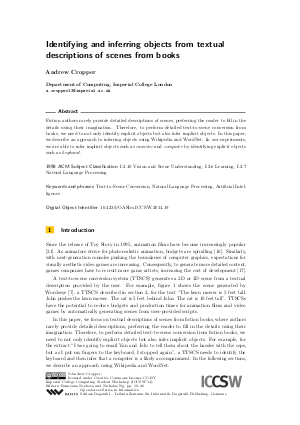Identifying and inferring objects from textual descriptions of scenes from books
Author Andrew Cropper
-
Part of:
Volume:
2014 Imperial College Computing Student Workshop (ICCSW 2014)
Part of: Series: Open Access Series in Informatics (OASIcs) - License:
 Creative Commons Attribution 3.0 Unported license
Creative Commons Attribution 3.0 Unported license
- Publication Date: 2014-10-08
File

PDF
OASIcs.ICCSW.2014.19.pdf
- Filesize: 0.58 MB
- 8 pages
Document Identifiers
Subject Classification
Keywords
- Text-to-Scene Conversion
- Natural Language Processing
- Artificial Intelligence
Metrics
- Access Statistics
-
Total Accesses (updated on a weekly basis)
0PDF Downloads0Metadata Views
Abstract
Fiction authors rarely provide detailed descriptions of scenes, preferring the reader to fill in the details using their imagination. Therefore, to perform detailed text-to-scene conversion from books, we need to not only identify explicit objects but also infer implicit objects. In this paper, we describe an approach to inferring objects using Wikipedia and WordNet. In our experiments, we are able to infer implicit objects such as monitor and computer by identifying explicit objects such as keyboard.
Cite As Get BibTex
Andrew Cropper. Identifying and inferring objects from textual descriptions of scenes from books. In 2014 Imperial College Computing Student Workshop. Open Access Series in Informatics (OASIcs), Volume 43, pp. 19-26, Schloss Dagstuhl – Leibniz-Zentrum für Informatik (2014)
https://doi.org/10.4230/OASIcs.ICCSW.2014.19
BibTex
@InProceedings{cropper:OASIcs.ICCSW.2014.19,
author = {Cropper, Andrew},
title = {{Identifying and inferring objects from textual descriptions of scenes from books}},
booktitle = {2014 Imperial College Computing Student Workshop},
pages = {19--26},
series = {Open Access Series in Informatics (OASIcs)},
ISBN = {978-3-939897-76-7},
ISSN = {2190-6807},
year = {2014},
volume = {43},
editor = {Neykova, Rumyana and Ng, Nicholas},
publisher = {Schloss Dagstuhl -- Leibniz-Zentrum f{\"u}r Informatik},
address = {Dagstuhl, Germany},
URL = {https://drops.dagstuhl.de/entities/document/10.4230/OASIcs.ICCSW.2014.19},
URN = {urn:nbn:de:0030-drops-47690},
doi = {10.4230/OASIcs.ICCSW.2014.19},
annote = {Keywords: Text-to-Scene Conversion, Natural Language Processing, Artificial Intelligence}
}
Author Details
References
-
Giovanni Adorni, Mauro Di Manzo, and Fausto Giunchiglia. Natural language driven image generation. In Proceedings of the 10th international conference on Computational linguistics, pages 495-500. Association for Computational Linguistics, 1984.

-
Ola Åkerberg, Hans Svensson, Bastian Schulz, and Pierre Nugues. Carsim: an automatic 3d text-to-scene conversion system applied to road accident reports. In Proceedings of the tenth conference on European chapter of the Association for Computational Linguistics-Volume 2, pages 191-194. Association for Computational Linguistics, 2003.

-
Steven Bird, Ewan Klein, and Edward Loper. Natural language processing with Python. " O'Reilly Media, Inc.", 2009.

-
Duy Bui, Carlos Nakamura, Bruce E Bray, and Qing Zeng-Treitler. Automated illustration of patients instructions. In AMIA Annual Symposium Proceedings, volume 2012, page 1158. American Medical Informatics Association, 2012.

-
Angel X Chang, Manolis Savva, and Christopher D Manning. Semantic parsing for text to 3d scene generation. ACL 2014, page 17, 2014.

-
Sharon Rose Clay and Jane Wilhelms. Put: Language-based interactive manipulation of objects. Computer Graphics and Applications, IEEE, 16(2):31-39, 1996.

-
Bob Coyne and Richard Sproat. Wordseye: an automatic text-to-scene conversion system. In Proceedings of the 28th annual conference on Computer graphics and interactive techniques, pages 487-496. ACM, 2001.

-
Sylvain Dupuy, Arjan Egges, Vincent Legendre, and Pierre Nugues. Generating a 3d simulation of a car accident from a written description in natural language: The carsim system. In Proceedings of the workshop on Temporal and spatial information processing-Volume 13, page 1. Association for Computational Linguistics, 2001.

-
Richard Johansson, David Williams, Anders Berglund, and Pierre Nugues. Carsim: a system to visualize written road accident reports as animated 3d scenes. In Proceedings of the 2nd Workshop on Text Meaning and Interpretation, pages 57-64. Association for Computational Linguistics, 2004.

-
Dhiraj Joshi, James Z Wang, and Jia Li. The story picturing engine - a system for automatic text illustration. ACM Transactions on Multimedia Computing, Communications, and Applications (TOMCCAP), 2(1):68-89, 2006.

-
Dan Jurafsky and James H Martin. Speech &language processing. Pearson Education India, 2000.

-
Marie Louise Lingaya. Automatic scene extraction from natural language text. Master’s thesis, Nottingham Trent University School of Science and Technology, UK, 2008.

-
Christopher D Manning, Prabhakar Raghavan, and Hinrich Schütze. Introduction to information retrieval, volume 1. Cambridge university press Cambridge, 2008.

-
Rada Mihalcea and Chee Wee Leong. Toward communicating simple sentences using pictorial representations. Machine Translation, 22(3):153-173, 2008.

-
George A Miller. Wordnet: a lexical database for english. Communications of the ACM, 38(11):39-41, 1995.

- K Onstad. Pixar gambles on a robot in love. http://www.nytimes.com/2008/06/22/movies/22onst.html, 2008. Accessed: 25-06-2014.
- J Reimer. Cross-platform game development and the next generation of consoles. http://arstechnica.com/old/content/2005/11/crossplatform.ars/7, 2005. Accessed: 25-06-2014.
-
Robert F Simmons. The clowns microworld. In Proceedings of the 1975 workshop on Theoretical issues in natural language processing, pages 17-19. Association for Computational Linguistics, 1975.

-
Richard Sproat. Inferring the environment in a text-to-scene conversion system. In Proceedings of the 1st international conference on Knowledge capture, pages 147-154. ACM, 2001.

-
Daniel Allen Tappan. Knowledge-based spatial reasoning for automated scene generation from text descriptions. PhD thesis, New Mexico State University, 2004.

-
Meng Wang. Research on the relationship between story and the popularity of animated movies. Master’s thesis, Purdue University, United States, 2012.

-
Terry Winograd. Procedures as a representation for data in a computer program for understanding natural language. Technical report, DTIC Document, 1971.

-
Xiaojin Zhu, Andrew B Goldberg, Mohamed Eldawy, Charles R Dyer, and Bradley Strock. A text-to-picture synthesis system for augmenting communication. In AAAI, volume 7, pages 1590-1595, 2007.

